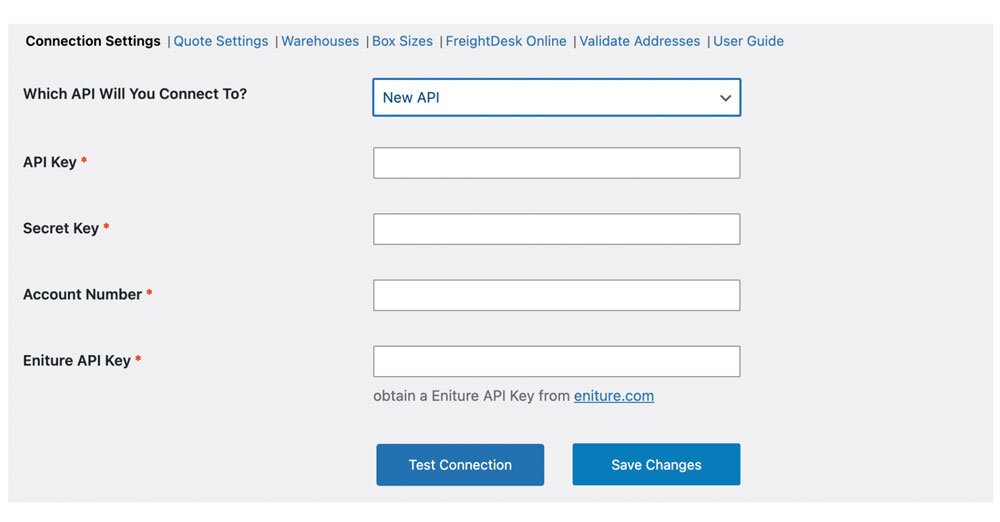This version of Eniture Technology’s Small Package Quotes plugin retrieves your negotiated parcel rates, takes action on them according to the plugin settings, and displays the results as shipping options in the WooCommerce cart and checkout page.
Setup Tutorial & Demo (10:30 min)
Basic Plan
Choose to display list or negotiated carrier rates to the cart and checkout page.
Supported origins: Any country from which the carrier provides service.
Supported destinations: Any country to which the carrier provides service.
Choose which services to offer to your shoppers.
Support for the One Rate program.
Support for SmartPost.
Mark up individual services by dollar amount or percentage.
Option to always include the residential delivery fee.
Identify one warehouse and multiple drop ship locations.
Compatible with the Residential Address Detection plugin which automatically includes the residential address delivery fee when the Ship To address is a residence.
Compatible with the Standard Box Sizes plugin for hyper-accurate rate estimates supported by step-by-step graphic illustrations of the packaging solution.
Support for individual items that ship as multiple packages. (Requires the Standard Box Sizes plugin)
Embed a handling charge in the displayed rates to recover the cost of packaging materials or other shipping related expenses.
Works intelligently with Eniture Technology’s LTL Freight Quotes plugins to identify when orders should be quoted as parcel shipments and when they should be quoted as LTL freight shipments.
Standard Plan
Everything in the Basic Plan, plus…
Define multiple warehouses.
The warehouse closest to the shopper is used as the shipment origin to keep shipping costs low and delivery times fast.
Option for quotes to include the Declared Value (Insurance) premium.
Support for products that ship as hazardous material.
Specify an order cut off time and have it reflected in the estimated delivery date.
Extend estimated delivery dates to account for lead times in manufacturing and/or fulfillment.
Identify the days of the week you ship orders and have it reflected in the estimated delivery date.
Advanced Plan
Everything in the Standard Plan, plus…
Use transit time to limit when Ground or Home Delivery is offered.
Offer in-store pick-up based on the shopper’s ZIP code or distance to the warehouse.
Offer local delivery based on the shopper’s ZIP code or distance to the warehouse.
Identify a charge for local delivery.
Current version: 4.0.17
Requirements
WooCommerce 5.7 or newer.
A carrier provided account number.
A carrier provided API password.
A carrier provided Meter Number.
A carrier provided web services authentication key.
A license from Eniture Technology.
FAQs
How do I get an account number?
Call 800-463-3339, or register online.
Where do I find my username and password?
Go to the carrier’s website and depending upon your circumstances click the Forgot your password or ID, or the Register now link .
Where do I get the Production Password, Authentication Key and Meter Number?
Click on the Documentation tab on this page and refer to Step 4 for detailed instructions on how to obtain these.
How do I get a license key for the plugin?
You must register your installation of the plugin, regardless of whether you are taking advantage of the trial period or purchased a license outright. At the conclusion of the registration process an email will be sent to you that will include the license key. You can also login to eniture.com using the username and password you created during the registration process and retrieve the license key from the My Licenses tab.
How do I change my plugin license from the trial version to one of the paid subscriptions?
Login to eniture.com and navigate to the My Licenses tab. There you will be able to manage the licensing of all of your Eniture Technology plugins. Refer to the Documentation tab on this page for more thorough instructions.
How do I install the plugin on another website?
The plugin has a single site license. To use it on another website you will need to purchase an additional license. If you want to change the website with which the plugin is registered, login to eniture.com and navigate to the My Licenses tab. There you will be able to change the domain name that is associated with the license key.
Do I have to purchase a second license for my staging or development site?
No. Each license allows you to identify one domain for your production environment and one domain for your staging or development environment. The rate estimates returned in the staging environment will have the word “Sandbox” appended to them.
Why isn’t the plugin working on my other website?
If you can successfully test your credentials from the plugin’s Connection page then you have one or more of the following licensing issues: 1) You are using the license key on more than one domain. The licenses are for single sites. You will need to purchase an additional license. 2) Your trial period has expired. 3) Your current license has expired and we have been unable to process your form of payment to renew it. Login to eniture.com and go to the My Licenses tab to resolve any of these issues.
Why were the shipment charges I received on the invoice from the carrier different than what was quoted by the plugin?
Common reasons include one of the shipment parameters (weight, dimensions) is different, or additional services (such as residential delivery) were required. Compare the details of the invoice to the shipping settings on the products included in the shipment. Consider making changes as needed. Remember that the weight of the packing materials is included in the billable weight for the shipment.
Why do I sometimes get a message that a shipping rate estimate couldn’t be provided?
There are several possibilities:
- The carrier has restrictions on a shipment’s maximum weight, length and girth which your shipment may have exceeded.
- There wasn’t enough information about the weight or dimensions for the products in the shopping cart to retrieve a shipping rate estimate.
- The carrier’s web service isn’t operational.
- Your account with the carrier has been suspended or canceled.
- Your Eniture Technology license key for this plugin has expired.
Installation & User’s Guide
If you are taking advantage of a trial subscription, the plugin will stop working when the trial period ends. Be sure to read the Managing Your Eniture API Key section to learn how to upgrade your subscription.
Overview
Setting up the plugin consists of the following steps:
- Download the installation file.
- Install the plugin application file.
- Activate the plugin.
- Get your web services credentials
- Connect the plugin
- Quote settings
- RAD (Residential Address Detection)
- Identify your warehouse and drop ship locations
- Enter your boxes.
- Enable the plugin.
- Configure your products.
Other information contained in this guide:
1. Download the Installation File |
Return to top. |
On the Features tab of this webpage (you’re currently on the Documentation tab) is a list of available subscription plans and a description of the features included in each one. Click on the green button associated with the plan you want to subscribe to. The image below shows where to click to sign up for a monthly subscription to the plugin’s Basic Plan. There is also a button for a free 15 day trial beneath the name of the plugin at the top of the page.

You will be presented with a registration form. The email address and password you enter will serve as your credentials to eniture.com. Use these to gain access to your customer dashboard where you can download the plugin installation file, manage your Eniture API Keys and update your payment information. When you download the plugin installation file, be sure to save it to a familiar location. You will need to navigate to the file during the installation process.
2. Install the Plugin Application File |
Return to top. |
Login to the WordPress dashboard as the website administrator.
In the left sidebar, hover your mouse over the Plugins menu to display the sub-menu options.
Select Add New from the sub-menu options. The Add Plugins page will load.
At the top of the Add Plugins page, click on the Upload Plugin button.

Controls will appear in the middle of page that will allow you to chose and install the plugin application. Choose the Choose File button, navigate to the location where you saved the installation file and select it.

Click the Install Now button.
WordPress will display information about the installation progress at the bottom of the page. The plugin has been installed once the message Plugin installed successfully is displayed.
3. Activate the Plugin |
Return to top. |
Once the plugin has been installed, it must be activated. If you are still on the same page that you were on at the end of Step 2, you can click the Activate Plugin link on the bottom of the page.
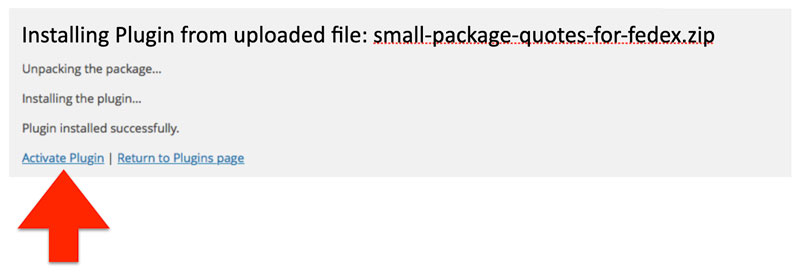
If you’ve already navigated away from that page, select Installed Plugins from the Plugins menu.

Locate the Small Package Quotes plugin on the list and click the Activate link.

4. Get your web service credentials |
Return to top. |
For 2024, FedEx released a new RESTful version of its API that replaces its SOAP version. Customers are asked to transition to the new RESTful API by August, 2024. The instructions in this User’s Guide will inform you how to get your credentials to FedEx’s new RESTful API. If you will be connecting to your FedEx account via the SOAP (legacy) API, please follow the instructions located at the following alternate URL:
Log in to fedex.com. Afterward, scroll to the bottom of the page and locate the FedEx Developer Portal link in the footer. Click on it to access the developer portal.Click on the link My Projects in the navigation menu.
In the center of the page, click on the + CREATE API PROJECT button.
You will be presented with a popup containing a dropdown field. Select the option, Ships with FedEx and needs to integrate FedEx APIs into their system and then click the NEXT button.
Click the SELECT button for the option titled, Ship, Rate & other APIs.
Beneath the SELECT button, you’ll be presented with with several boxes, each representing a different API. Enable the checkboxes for the APIs that have the following names…
- Freight LTL API
- Rates and Transit Times API
- Service Availability API
…and afterward click the NEXT button at the bottom of the page.
On the next page, give your project a name or accept the default if one is provided. Beneath the project name field, is a Country/territory field. The purpose of this field is solely for test account purposes. You will be promoting the API credentials to Production in a moment, so select United States to satisfy the form. Answer No to the question, Do you plan on shipping using FedEx SmartPost Returns? Answer Yes to the question, Do you plan on shipping using FedEx Freight LTL? even if your immediate interest is only in FedEx parcel shipping. Click NEXT to advance to next page.
Enable both checkboxes to accept terms, and then click the CREATE button.
You will be delivered to a page where you will be viewing your Test credentials. You need to obtain your Production credentials. Near the top of the page, click the Production Key link.

Assign your production key a Key name or accept the default. Select your account number from the dropdown field and then click the NEXT button.
Your Production keys will appear on the page. Copy them to where you can retrieve them later. You will need them later in this guide. Click the Done button to complete the process of obtaining your API credentials.
5. Connection Settings |
Return to top. |
If you are connecting to the FedEx SOAP (legacy) API, instead follow the instructions located at the following alternate URL: WooCommerce / Legacy API Connection for FedEx
Select Settings from the WooCommerce menu.
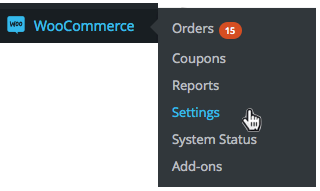
Click on the Connection Settings.
| Which API Will You Connect To? | Choose New API from the dropdown. This will connect you to FedEx’s new RESTful API. |
| API Key | Enter the API Key you were given when obtaining your FedEx API credentials. |
| Secret Key | Enter the Secret Key you were given when obtaining your FedEx API credentials. |
| Account Number | Enter your FedEx account number. |
| Eniture API Key | Enter the API Key you obtained from Eniture Technology. If you don’t have one, click the link to the right of this field to obtain one.
Related documents:
How To Obtain Your Eniture API Key |
The Eniture API Key will be tied to a subscription. The Trial Plan will give you 15 days of free access to the Basic Plan. Two other plans are available; the Standard Plan and the Advanced Plan. The features associated with each plan are listed on the Features tab of this web page. Each plan is available for a monthly or yearly subscription rate. To manage your Eniture API Key, including which plan is associated with it, see the section titled Managing your Eniture API Keys at the end of this User’s Guide.
When you’re done save your connection settings and then test them by clicking on the Test Connection button at the bottom of the page. A message will display at the top of the page letting you know if the plugin succeeded in establishing a connection to the the carrier’s servers. If you receive an error, confirm the values you entered and try again. Be particularly attentive to capitalization. Most of the information you enter on this page is case sensitive.
6. Quote Settings |
Return to top. |
If you don’t have visibility to the plugin’s navigation menu, select Settings from the WooCommerce menu.

Click on the plugin’s tab to gain access to the plugin configuration settings. Using the links at the top of the page, select Quote Settings.
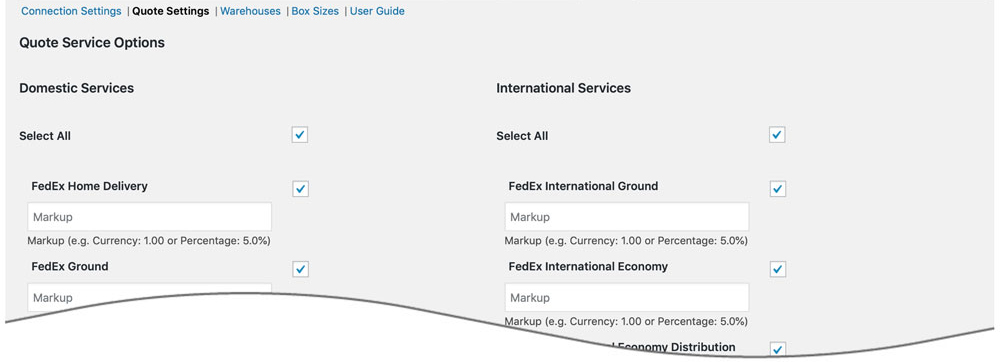
| Quote Service Options | Place checkmarks next to the services you want displayed in your shopping cart at checkout. Selected services will be displayed only if the destination is included in a corresponding shipping zone and the service is offered to that zone. Check the carrier’s service guide for a description of its services.
Beneath each service is a markup field. You can enter a dollar amount (e.g. 5.00) or percentage (e.g. 3.5%) in the field if you’d like to mark up the rate returned for that service. You can also enter a negative value if you want to mark down the rate. To make a service free, enter “-100%”. Later in the Quote Settings there is a general Handling Fee / Mark Up field that will be applied to all returned rate estimates. The service level markups are applied before the general setting. One Rate services require that the carrier has authorized your account to use the One Rate program. SmartPost quotes will only be presented as an option during checkout when: 1) The carrier has it enabled on your account; 2) It is enabled in the Quote Settings; 3) The packaging solution for the order involves only one box; 4) No other service related restrictions are violated. |
| Don’t sort shipping methods by price | By default, the plugin will display all returned shipping quotes (including those coming from other plugins / shipping methods) by price in ascending order. You can disable this behavior by checking this box. If you do, shipping quotes from each shipping method will be ordered as they appear in the Woocommerce > Settings > Shipping > Shipping Zone. |
| Package rating method when Standard Box Sizes isn’t in use | Quote each item as shipping as its own package. Select this option if you want each item in the Cart to be quoted as its own package. Combine the weight of all items without dimensions and quote them as one package while quoting each item with dimensions as shipping as its own package.
This option will sum the weight of all the items in the Cart that are missing dimensions and treat them as a single package. The billable weight of this package will be its actual weight. Items in the Cart that have dimensions will be quoted as shipping as their own package. The billable weight of these packages will be the greater of the dimensional or actual weight as per the carrier’s service guidelines. Quote shipping as if all items ship as one package up to 70 LB each
Rates for shipping will be based on weight only. If the total weight of the Cart exceeds 70 LB, the total weight of the Cart will be divided by 70 to determine the number of packages, and each package will have the same weight. Quote shipping as if all items ship as one package up to 150 LB each
Rates for shipping will be based on weight only. If the total weight of the Cart exceeds 150 LB, the total weight of the Cart will be divided by 150 to determine the number of packages, and each package will have the same weight. Use the default Eniture packaging algorithm.
Prior to introduction of Standard Box Sizes, the plugin used a modified volume calculation to approximate a virtual box for the contents of the Cart. It helped determine if the billable weight of the shipment would be based on dimensional or actual weight. The Standard Box Sizes feature is more accurate, but the default packaging algorithm can be an acceptable alternative in some cases. |
| Delivery Estimate Options | Don’t display delivery estimates Only the shipping rate for the enabled services will display when this option is selected. Display the estimated number of days until delivery
The estimated days until delivery will be displayed after each enabled service name and before the rate estimate.Weekend days and holidays are included in the estimate. For example, if an overnight shipment is quoted with a ship-date of a Thursday, the estimated number of days until delivery will be one. But if the same overnight shipment is quoted with a ship-date of a Friday, the estimated number of days until delivery will be three to include Saturday and Sunday; and provided that the following Monday is not a holiday.The shipment date will be the date of the order, unless you are using the Order Cut Off Time or Fulfillment Offset Days feature to adjust the shipment date. Display estimated delivery date
The date and time of the estimated delivery date will be displayed after each enabled service name and before the rate estimate.Weekend days and holidays are accounted for. For example, if an overnight shipment is quoted with a ship-date of a Friday, the estimated delivery date date will be the following Monday, provided that the following Monday is not a holiday.The shipment date will be the date of the order, unless you are using the Order Cut Off Time or Fulfillment Offset Days feature to adjust the shipment date. |
| Cut Off Time & Ship Date Offset | The Standard Plan is required to use these features. If you aren’t on the Standard Plan the words Standard Plan required will be displayed. Click on the Standard Plan required text to upgrade your plan and gain access to these features.
The features are only relevant if you have Show Delivery Estimates enabled. Workdays are Monday through Friday except for the public holidays on which the carrier does not provide pick up service. Order Cut Off Time
Enter the cut off time for orders. When the plugin requests shipping quotes, it identifies a shipment date. The estimated delivery date is dependent on the ship date. The cut off time allows you to postpone an order’s shipment date by one workday. Orders received before the cut off time are quoted using the order date as the ship date. Orders received after the cut off time use the next workday as the ship date. Fulfillment Offset Days
Enter the number of days to offset the ship date. When the plugin requests shipping quotes, it identifies a ship date. The estimated delivery date is dependent on the ship date. This setting allows you to postpone the ship date by a specified number of workdays. Example 1 Example 2 What days do you ship orders?
Identify the days of the week on which you ship orders. The ship date used for the rate request will be modified accordingly, which may affect the expected delivery date. |
| Ground transit time restrictions | The Advanced Plan is required to use this feature. If you aren’t on the Advanced Plan the words Advanced plan required will be displayed. Click on the Advanced plan required text to upgrade your plan and gain access to the feature.
This feature is commonly used by merchants who sell perishable products and need to prevent Ground service from displaying as an option when the shipment transit time exceeds a certain number of days. Enter the number of transit days to restrict ground service to. Leave blank to disable this feature.
In the box provided, enter the maximum number of days your products can be in transit. Leave blank to disable this feature. Restrict by the calendar days in transit
Pick this option to if you want to include weekends and holidays when determining if Ground service will be displayed. Choose this option if you always ship orders at the first opportunity to do so. Restrict by the carrier’s in transit days metric
Pick this option to apply the rule based on the carrier’s in transit days estimate. Carriers identify the in-transit days as business days. Choose this option if you hold orders until a ship date occurs upon which the order can be shipped and not be delayed by weekends or holidays. |
| Rates | Choose if you want to retrieve list rates, or rates that reflect your negotiated discount. |
| Always quote as residential delivery | When checked, the quotes returned quotes will include the residential delivery fee.
This setting is binary. When it is enabled, every ship-to address will be quoted as being to a residential address and include the residential delivery fee. When it is disabled, every ship-to address will be quoted as being to a commercial address. To have the address type determined dynamically during checkout, install the Residential Address Detection add-on plugin and refer to the instructions in this guide for “RAD (Residential Address Detection)”.
|
| Use my standard box sizes | Through the use of an addon plugin titled Standard Box Sizes, you can define your standard box sizes which the plugin will use to identify the optimal packaging solution. The result is hyper-accurate shipping rate estimates. The packaging solution is saved as a step-by-step graphical illustration which is accessed from the Order Details page. If the message “Click here to add the Standard Box Sizes module.” is present, then the add on plugin is not installed. Click on the link to install it if you’d like to use this feature, or click (Learn more) to find out more information on this feature. If you have a Box Sizes option in the plugin navigation links, then you already have the add on plugin installed. Refer to Step 8 for instructions. |
| Hazardous material settings | The Standard Plan or higher is required to use this feature. If you aren’t on the Standard Plan or higher the words Standard plan required will be displayed. Click on the Standard plan required text to upgrade your plan and gain access to the feature.
Only quote ground service for hazardous materials shipments
Check this box if you only want ground service quoted in the event that one or more of the products in the shopping cart is identified as hazardous material. Ground Hazardous Material Fee
Enter in the amount that should be added to the ground rate estimate in the event that one or more of the products in the shopping cart is identified as hazardous material. The fee will only be added once per shipment. Air Hazardous Material Fee
Enter in the amount that should be added to the air service estimates in the event that one or more of the products in the shopping cart is identified as hazardous material. The fee will only be added once per shipment. A special agreement/contract may be required to use air services to ship hazardous materials. |
| Handling Fee / Mark Up | Increases the amount of each returned quote by a specified amount prior to displaying it/them in the shopping cart. The number entered will be interpreted as dollars and cents unless it is followed by a % sign. For example, entering 5.00 will cause $5.00 to be added to the quotes. Entering 5.00% will cause each quote to be multiplied by 1.05 (= 1 + 5%). |
| Enable Logs | Enable the checkbox to have API transactions logged on the Logs page. The plugin’s navigation will only display an entry for Logs when this setting is enabled. The page will contain as many as 25 of the most recent transactions. |
| Ignore items with the following Shipping Class(es) | Enter the Shipping Slug you’d like the plugin to ignore. Use commas to separate multiple Shipping Slugs. A Shipping Slug is the string that Woocommerce uses internally for a Shipping Class. For example, the LTL Freight Quotes plugin makes use of the Shipping Class LTL Freight, The Shipping Class’s slug is ltl_freight. You can navigate to Woocommerce > Settings > Shipping > Shipping Classes to see a list of your Shipping Classes and their associated slugs. |
| Allow other plugins to show quotes(Yes|No) | Permit or prevent the display of shipping rates from other plugins. |
| Checkout options if the plugin fails to return a rate | Choose how you want the cart to behave if the plugin fails to return shipping rates. You can allow the customer to complete the transaction, or prevent the customer from continuing. The text area below each option allows you to customize the message that will display in the cart. |
7. RAD (Residential Address Detection) |
Return to top. |
The RAD (Residential Address Detection) option in the plugin navigation menu will be present only if the Residential Address Detection add-on plugin is installed and activated.
| Subscription Selection | Auto-renew Choose a plan that best meets your needs. The credit card associated with quote plugin license will be billed immediately and the plan will become your current plan. Your choice will be retained for the auto-renew option. You can change your auto-renew selection at any time. Plans automatically renew at the end of every monthly billing cycle or upon the depletion of the current plan. To prevent a renewal, choose Disable from the list of options. Current plan
Displays information about the current plan and the start and end dates of the current subscription period. Current Usage
Displays information about the consumption of the current plan. The date shown is the UTC timestamp of the last time a residential address detection event occurred. Suspend use
Checking this box temporarily suspends the Residential Address Detection plugin. It does not permanently disable it and if the current monthly billing cycle expires, a new plan will be activated. To disable the plugin, deactivate it or choose Disable from the Auto-renew drop down. |
| Default Unconfirmed Addresses | Default unconfirmed addresses to In rare cases, the plugin may be unable to confirm the address type. This occurs when a match for the address can’t be found in the USPS database. Invalid addresses are the most common reason for this. In extremely rare cases an address may be valid, but the match found in the USPS database has a low confidence metric. Choose how you want addresses treated in these cases. Residential
Choose this setting if you want unconfirmed addresses to be treated as residential. Commercial
Choose this setting if you want unconfirmed addresses to be treated as commercial. Address type disclosure
This setting allows you to choose whether or not to inform the shopper when the ship-to address has been quoted as a residential address. Inform the shopper when the ship-to address is identified as residential
Recommended. Choose this setting when you want to inform the shopper that their ship-to address has been identified as a residential address. Don’t disclose the address type to the shopper
Choose this setting if you don’t want to inform the shopper when their ship-to address has been identified as a residential address. |
| Do not return rates if the shipping address appears to be a post office box | Enable this setting if you don’t want the plugin to present shipping quotes when the ship-to address appears to be a post office box. Addresses in the United States will rely on metadata provided by the USPS for this determination. String matching, which is less reliable, will be used for addresses in other countries. |
| Address Type Overrides | This section will allow you to set the address type of specific addresses. When an address appears in this table, the address type recorded is used for quoting purposes and the USPS database is not consulted. To add an address, click on the Add new address link and complete the form. |
8. Define Warehouse and Drop Ship Locations |
Return to top. |
If you don’t have visibility to the plugin’s navigation menu, select Settings from the WooCommerce menu.

Click on the plugin’s tab to gain access to the plugin configuration settings. Using the links at the top of the page, select Warehouses.
Click the Add button in the appropriate sections to add warehouse and drop ship locations. On the Basic Plan you can define one warehouse and multiple drop ship locations. To define multiple warehouse locations you must be on the Standard Plan or higher.
Warehouses should have a complete inventory of all products not otherwise identified as drop shipped items. If you have more than one warehouse defined, the warehouse closest to the shopper will be used to retrieve shipping rate estimates. You should define at least one warehouse, even if all of your products are drop shipped. This insures that quotes will be returned in the event the drop ship location was overlooked when the product entry was created.
Drop ship locations usually represent vendors that supply items that you don’t inventory. These items are shipped directly to your customer on your behalf. When an order includes drop shipped items the shopping cart will display a single figure for the shipping rate estimate that is equal to the sum of the cheapest option for each shipment required to fulfill the order.
Warehouses vs. Drop Ship Locations
How the Plugin Presents Quotes with Multiple Shipment Origins
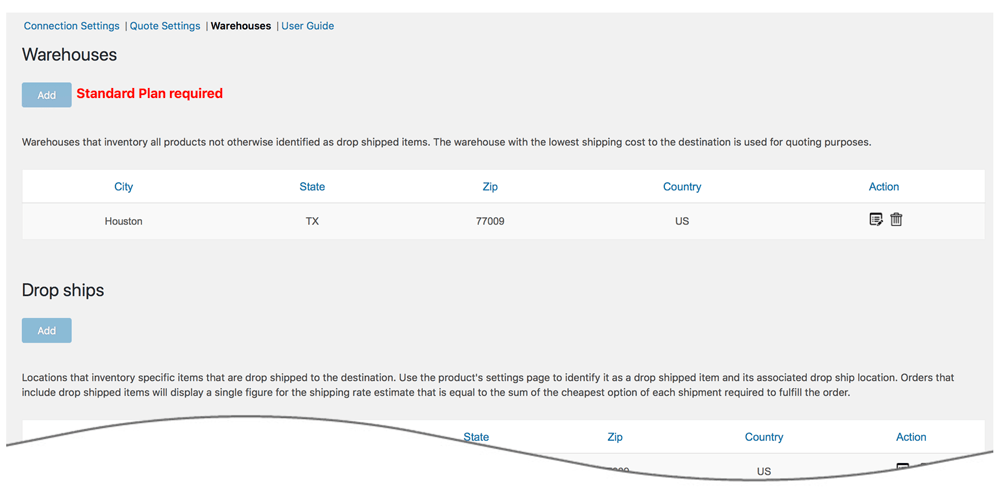
| Steet Address | Optional. Enter the street address for the location. This will be displayed along with the city, state, and postal code when the setting for in-store pick up is enabled. |
| ZIP | Enter the postal code for the location. Enter only the five digit ZIP Code for US addresses. |
| City | The plugin will attempt to prefill the City based on the postal code. Edit it if the prefilled value is incorrect. |
| State | The plugin will attempt to prefill the State based on the postal code. Edit it if the prefilled value is incorrect. |
| Country | The plugin will attempt to prefill the Country based on the postal code. Edit it if the prefilled value is incorrect. Use only the two character standardized country code. |
| Handling Fee / Mark Up | Increases the amount of the quote received for this location by a specified amount prior to displaying it/them in the shopping cart. The number entered will be interpreted as dollars and cents unless it is followed by a % sign. For example, entering 5.00 will cause $5.00 to be added to the quotes. Entering 5.00% will cause each quote to be multiplied by 1.05 (= 1 + 5%).
Note: The plugin has four settings that can be used to mark up shipping quotes. They are applied to shipping quotes in the following order: 1) Product-specific Mark Up (Product settings); 2) Location-specific Handling Fee / Mark Up (Warehouse settings); 3) Service-specific Mark Up (Quote settings); and 4) General Handling Fee / Mark Up (Quote settings).
|
8a. In-store pick up settings |
Return to top. |
The Advanced Plan is required to use this feature. If you aren’t on the Advanced Plan the words Advanced plan required will appear adjacent to the settings header, and the fields associated with the feature will be inaccessible.
In-store pick up can be offered as an option in the checkout process based the shopper’s postal code or proximity. It will only be offered if the feature is enabled and only one stocking location (warehouse or drop ship location) is involved in providing a quote. The settings for In-store pick up are visible on the page used to add or edit a warehouse or drop ship location.
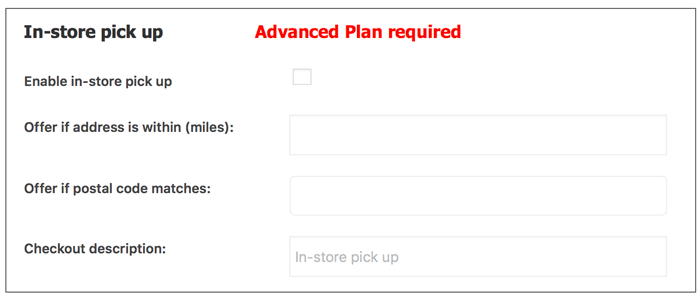
| Enable in-store pick up | Check the box to enable the in-store pick up feature. |
| Offer if address is within (miles) | The distance in miles within which you’d like to offer in-store pick up. The distance is route miles (driving distance). Leave blank if you don’t want to use distance to determine if in-store pick up should be offered. If both distance and postal codes are used as evaluation criteria, in-store pick up will display if either is satisfied. |
| Offer if postal code matches | The postal codes to which you’d like to offer in-store pick up. Enter only the five digit ZIP Code for US addresses. Leave blank if you don’t want to use postal codes to determine if in-store pick up should be offered. If both distance and postal codes are used as evaluation criteria, in-store pick up will display if either is satisfied. |
| Checkout description | The description to use to identify the option in the checkout process. The most obvious candidate is In-store pick up, but you can make it anything you’d like. |
| Phone number | Enter the phone number to display in the description of the in-store pickup option. |
8b. Local delivery settings |
Return to top. |
The Advanced Plan is required to use this feature. If you aren’t on the Advanced Plan the words Advanced plan required will appear adjacent to the settings header, and the fields associated with the feature will be inaccessible.
Local delivery can be offered as an option in the checkout process based the shopper’s postal code or proximity. It will only be offered if the feature is enabled and only one stocking location (warehouse or drop ship location) is involved in providing a quote. Local delivery can display as a free option or have a charge associated with it. Other shipping options provided by the plugin can be suppressed when local delivery is to be offered. The settings for Local delivery are visible on the page used to add or edit a warehouse or drop ship location.
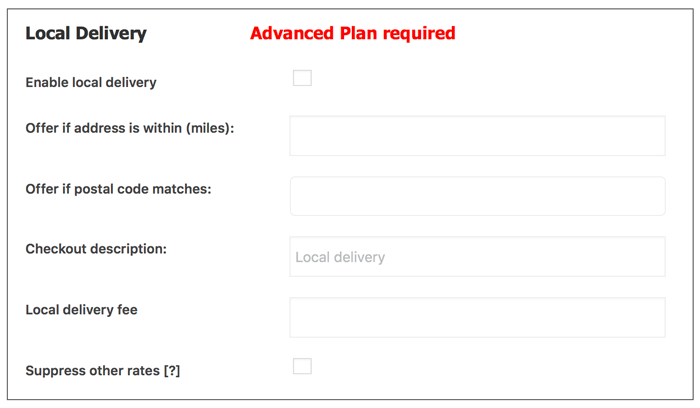
| Enable local delivery | Check the box to enable the local delivery feature. |
| Offer if address is within (miles) | The distance in miles within which you’d like to offer local delivery. The distance is route miles (driving distance). Leave blank if you don’t want to use distance to determine if local delivery should be offered. If both distance and postal codes are used as evaluation criteria, local delivery will display if either is satisfied. |
| Offer if postal code matches | The postal codes to which you’d like to offer local delivery. Enter only the five digit ZIP Code for US addresses. Leave blank if you don’t want to use postal codes to determine if local delivery should be offered. If both distance and postal codes are used as evaluation criteria, local delivery will display if either is satisfied. |
| Checkout description | The description to use to identify the option in the checkout process. The most obvious candidate is Local delivery, but you can make it anything you’d like. |
| Local delivery fee | Enter the amount to charge for local delivery. Leave blank to offer local delivery for free. |
| Suppress other rates | Check the box to show only the option for local delivery when the criteria for doing so (distance or postal code) is met. Leave unchecked to have local delivery offered in addition to the shipping options normally displayed by the plugin. |
9. Enter your boxes |
Return to top. |
The Standard Box Sizes plugin is an optional add-on plugin that will allow you to receive hyper-accurate shipping rate estimates. The plugin is required for flat rate shipping services, such as One Rate. With the Standard Box Sizes plugin installed, you can identify:
- The sizes of the boxes you inventory.
- The rotational property of items that can be packed in a box with other items.
- Items that ship as their own package (Can’t be packed in a box with other items).
- Items pre-packaged to ship in more than one box.
When items in the cart can be packaged together, the plugin will identify the best box(es) to use for the order and send the packaging solution to the carrier when requesting rates. The packaging solution is saved as a step-by-step graphical illustration which you can access from the Order Details page. Use the step-by-step instructions to pack the order exactly as it was quoted.
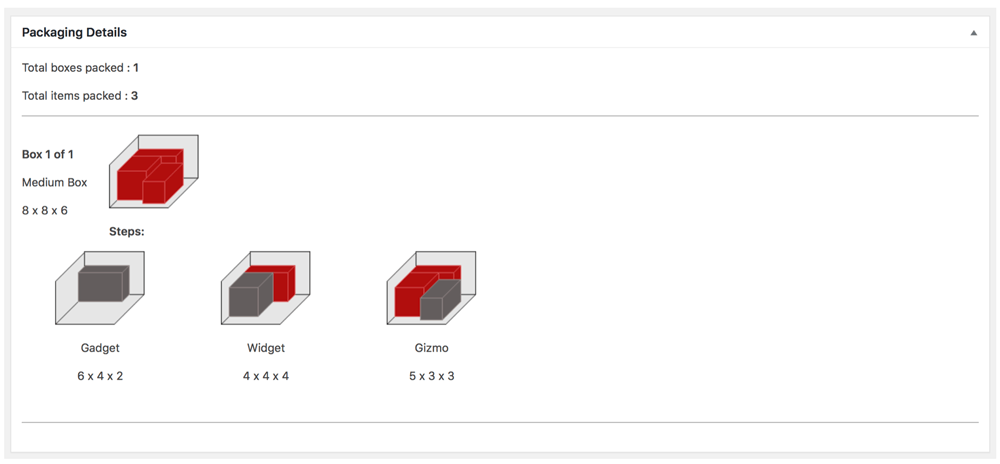
If you elect not to use the Standard Box Sizes add-on plugin, a free built-in algorithm will be used to identify a packaging solution for the order. The built-in algorithm will create as large of a box as needed (but within the carrier’s service guidelines) to accommodate all of the items in the cart. The built-in algorithm will be sufficient for some merchants, particularly those whose shipping charges are not affected by dimensional weight rules.
Dimensional weight is an extremely important factor when calculating rates for parcel services. Have a clear understanding of the topic when deciding whether or not to use the Standard Box Sizes add-on plugin. (Learn more about dimensional weight)
If you have the Standard Box Sizes plugin installed, Box Sizes will appear as an option in the plugin navigation menu. If it doesn’t and you want to use this feature, go to the Standard Box Sizes product page where you can learn more and download the plugin installation file.

9a. Identify your standard box sizes |
Return to top. |
If you don’t have visibility to the plugin’s navigation menu, select Settings from the WooCommerce menu.

Click on the plugin’s tab to gain access to the plugin configuration settings. Using the links at the top of the page, select Box Sizes.
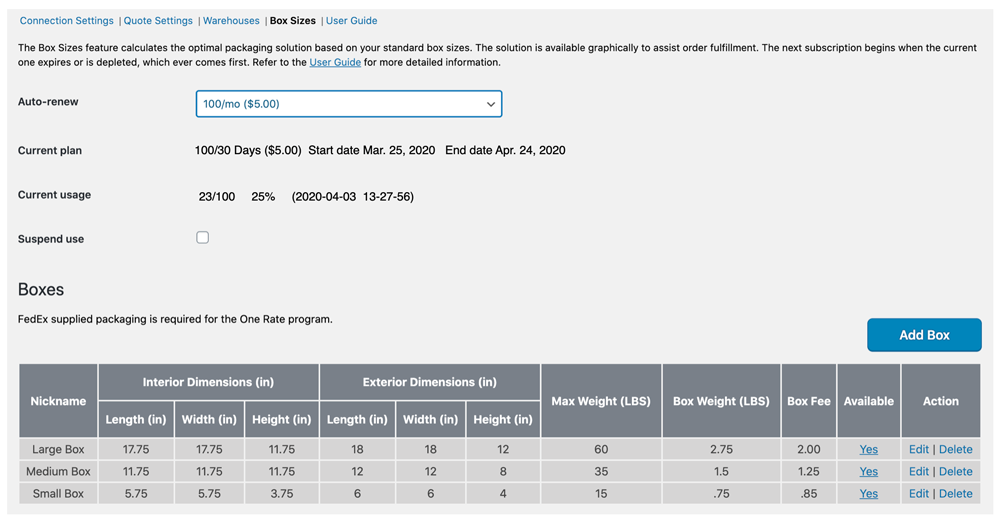
Below is an excerpt from the Standard Box Sizes User’s Guide to assist you with populating the associated settings.
| Select a plan (aka Auto-renew) | Choose a plan that best meets your needs. The plugin comes with a free 15 day trial, or 100 transactions, which ever comes first. After the trial expires, the credit card associated with quote plugin license will be billed and the plan selected will become your current plan. Your selection will be retained for the auto-renew option. You can change your auto-renew selection at any time. Plans automatically renew at the end of every monthly billing cycle or upon the depletion of the current plan. To prevent a renewal, choose Disable from the list of options. |
| Current plan | Displays information about the current plan and the start and end dates of the current subscription period. |
| Current usage | Displays information about the consumption of the current plan. The date shown is the UTC timestamp of the last time a packaging solution was identified.
The current plan is decremented only when the packaging algorithm is used to identify a packaging solution using your list of standard box sizes. The packaging algorithm is not used (and therefore the current plan is not charged) for items that have the setting Ships as own package or This item ships as multiple packages enabled. These settings appear on the Product > Shipping page. |
| Suspend use | Checking this box temporarily suspends the Standard Box Sizes plugin. It does not permanently disable the feature and if the current monthly billing cycle expires, a new plan will be activated. To disable the plugin, deactivate it or choose Disable from the Auto-renew drop down. |
| Optimization mode | The packaging algorithm arrives at a solution by prioritizing whether to minimize the amount of empty space in the packages (e.g. boxes) or by minimizing the number of packages in the shipment. For example, the packaging solution may yield two boxes with 5% of empty space when space utilization is prioritized, or one larger box with 20% of empty space if the number of packages is prioritized.
Maximize space utilization
Choose this option if you want the packaging algorithm to prioritize space utilization when arriving at a packaging solution. Minimize the number of packages
Choose this option if you want the packaging algorithm to prioritize the number of packages (fewer is better) when arriving at a packaging solution. |
To add a box, click the Add Box button. A popup will display prompting you for the following information about the box:
| Nickname | Enter a nickname for the box. The nickname will be used to identify the box in the graphical illustration of the packaging solution. |
| Box Type | Choose a box type from the drop-down list. Choose Merchant defined box for boxes you purchase from a supplier like Uline. If the box came from a carrier (e.g., FedEx, UPS, USPS), choose the entry that most accurately describes it. Packaging solutions that use carrier sourced boxes are available only for the services offered by that carrier. Boxes intended for specific service offerings, such as flat rate shipping, are restricted to those services. |
| Interior Length | The interior length of the box in inches. |
| Interior Width | The interior width of the box in inches. |
| Interior Height | The interior height of the box in inches. |
| Exterior Length | The length of the box in inches. |
| Exterior Width | The width of the box in inches. |
| Exterior Height | The height of the box in inches. |
| Max Weight | The maximum amount the box is allowed to weigh, entered as pounds. This includes the weight of the box. |
| Box Weight | The weight of the box in pounds. |
| Box Fee | Enter the amount you want to charge, if any, for the box when it is used in the packaging solution. The amount will be included in the shipping quote. |
| Box Use | Universally available for use Select this option if the box can be used to package any product product in the product catalog, as long as the product will fit in the box. For use only with specific products
Select this option if the box should be considered only for specific products. Product Tags
This setting is relevant only when the setting For use only with specific products is enabled. Enter the product tags that will be used to identify the products for which the box will be considered. |
| Availability | Available for FedEx Express and One Rate services (default) Enable this setting if this box will be used for both FedEx Express services (e.g. Priority, Standard, Second Day, etc.) and One Rate services. Available for FedEx Express (air services) only
Enable this setting if the box will be used only for FedEx Express services but not for One Rate. Available for One Rate service only
Enable this setting if the box will be used only for One Rate service. |
| Available | Check this box to make it available for the packaging solution calculations. |
9b. Items that ship as multiple packages |
Return to top. |
When you install the Standard Box Sizes plugin, a setting is added to the Product > Shipping page to allow you to indicate that the item ships as multiple packages. When you enable the setting, the item will appear on the Box Sizes page in the Items that ship as multiple packages section.

To add a box, click the Add Box button. A popup will display prompting you for the following information about the box:
| Quantity | Enter the number of boxes there are of this size. |
| Nickname | Enter a nickname for the box. The nickname will be used to identify the box in the graphical illustration of the packaging solution. |
| Length | The length of the box in inches. |
| Width | The width of the box in inches. |
| Height | The height of the box in inches. |
| Weight | The weight of the box in pounds. |
If you also have one of Eniture Technology’s LTL Freight Quotes plugins installed, it will use the Freight Class and Weight entered on the Product Shipping Parameters page when an LTL freight quote will be returned. However, if the Freight Class is set to Density Based (and the Item ships as multiple packages setting is enabled), then a freight class for the item will be calculated using the weight and dimensions of the boxes entered here.
10. Enable the Plugin (WooCommerce 3.0 or later only) |
Return to top. |
Select Settings from the WooCommerce menu.

Click on the Shipping tab and select the option for Shipping Zones.

The shipping method needs to be added to a shipping zone. If an appropriate shipping zone isn’t already defined, click the Add shipping zone button and define one.

Now add the shipping method to the zone. Click on the “+” inline with the shipping zone…

…select the plugin from the drop down list of shipping methods…
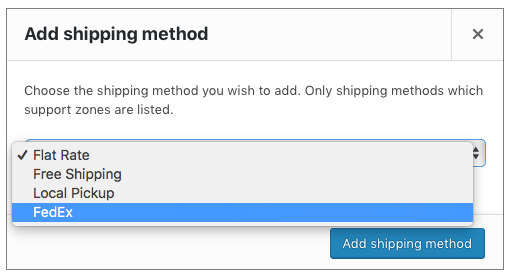
…and click on the Add shipping method button.
Repeat this process for each shipping zone you want to the plugin to return quotes for. You should test each zone to make sure the geography defined by the shipping zone is supported by the plugin.
11. Product Settings |
Return to top. |
The products you intend to sell and ship should have their shipping weight and dimensions recorded. Your shipping rate is based on the billable weight of the shipment, which is equal to the greater of the shipment’s actual weight or dimensional weight. The omission of weight or dimensions, or inaccuracies in the values of either, will impact the accuracy of the shipping rates displayed in the shopping cart. To learn more about determining the billable weight of a shipment refer to this article from our knowledge base.
To record the weight and dimensions of a product, navigate to your product list in the WordPress Dashboard by selecting Products from the Products menu.
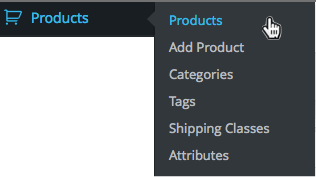
Select the product you want to update. Once you’re on the Edit Product page, locate the Product Data region and click on the Shipping option to access the product’s shipping characteristics.
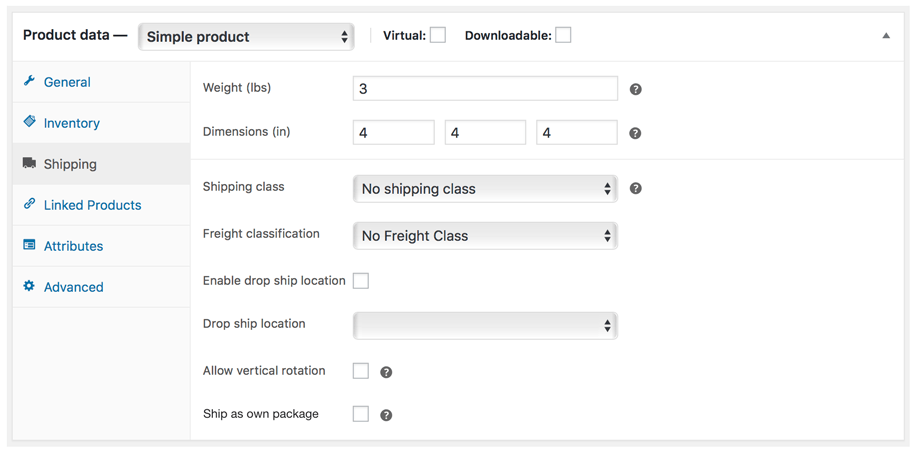
| Weight | Enter the weight of the product in pounds. |
| Dimensions | Enter the dimensions of the product in inches. |
| Shipping Class | If you have the Small Package Quotes plugin installed and you wish the product quoted as shipping parcel, select the No shipping class option.
If you have the LTL Freight Quotes plugin installed and you wish the product quoted as shipping LTL freight, select the LTL Freight option. |
| Freight Classification | This option will only be visible if the LTL Freight Quotes plugin is installed.
Select the freight class for the product from the list of options. If you utilize both small package (parcel) and LTL freight shipping methods, you should identify the freight class for all products, even those that normally ship small package (parcel). The last option in the list of freight classifications is Density Based. In most cases this is an industry accepted alternative for identifying the freight class of an item or shipment. Validate the returned quotes if using this setting. There are exceptions in the NMFC Freight Classification Directory that can render the density calculator results invalid for particular commodities. To be used successfully the product must have its weight and dimensions populated in the Shipping sub-panel. |
| Markup | Use this field to modify the shipping quotes returned by the plugin. Enter a dollar amount (e.g. 1.00 or -1.00) to increase or decrease the shipping quotes. The amount of the adjustment will be multiplied by the quantity of the item in the Cart. Enter a percentage (1.0% or -1.0%) to have a percentage of the item’s price added to or subtracted from the shipping quotes. When a percentage is entered and there is more than one of the item in the Cart, the percentage will be applied to the extended price (quantity x price).
Note: The plugin has four settings that can be used to mark up shipping quotes. They are applied to shipping quotes in the following order: 1) Product-specific Mark Up (Product settings); 2) Location-specific Handling Fee / Mark Up (Warehouse settings); 3) Service-specific Mark Up (Quote settings); and 4) General Handling Fee / Mark Up (Quote settings).
|
| Exempt from Ground Transit Time Restriction | The Advanced Plan is required to use this feature.
The Quote Settings includes a feature named, “Ground transit time restriction” that allows merchants to suppress the option for ground delivery service based on the time-in-transit to the ship-to address. It is a feature that is important for perishable goods. If you have the “Ground transit time restriction” feature enabled but don’t want to apply it to this item (e.g. the item is not perishable) enable this checkbox. Carts with a mixture of items for which the “Ground transit time restriction” applies and items for which it does not apply will honor the “Ground transit time restriction” setting.
|
| Nested item | The Advanced Plan is required to use this feature. If you aren’t on the Advanced Plan the words Advanced plan required will appear adjacent to the settings header, and the fields associated with the feature will be inaccessible.
Enable this checkbox if the item can be stacked into another identical item when it is shipped. An example would be 13 gallon trashcans or plastic cups. When this setting is enabled, the Freight Class is always Density Based. |
| Nesting percentage | This setting is only relevant if the Nested item setting is enabled.
Enter the percent of the item that can be nested inside of another identical item. For example, if an item is 10 inches in height and after stacking two together the total height is 11 inches, the stacking percentage is 90%. (11 inches = 10 inches + (10 inches x 90%)) |
| Nested dimension | This setting is only relevant if the Nested item setting is enabled.
Identify the dimension (length, width or height) on which the nesting occurs. |
| Maximum nested items | This setting is only relevant if the Nested item setting is enabled.
Enter the maximum number of items you’ll allow in a single stack of nested items. |
| Stacking property | This setting is only relevant if the Nested item setting is enabled.
Select Maximized or Evenly. If your Maximum nested items is 6, and there are 7 items in the cart, then the Maximized option will result in one stack of 6 and one of 1. If the Stacking property is set to Evenly, it will result in one stack of 4 and one of 3. |
| Enable Drop Ship Location | This option will only be visible if there are drop ship locations defined. Refer to step 7: Define Warehouse and Drop Ship Locations for instructions on how to define drop ship locations.
Check this box if this product ships from a drop ship location. |
| Drop Ship Location | This option will only be visible if there are drop ship locations defined. Refer to step 7. Define Warehouse and Drop Ship Locations for instruction on how to define drop ship locations.
If the product is drop shipped, select the drop ship location from the list of options. |
| Allow vertical rotation | This option will only be visible if Standard Box Sizes plugin is installed. Refer to step 8. Enter your boxes for instructions on how to identify your box sizes.
Enabling this setting allows the item to be rotated while identifying a packaging solution involving standard box sizes. This setting provides the most flexibility for arriving at a packaging solution. |
| Ship as own package | This option will only be visible if Standard Box Sizes plugin is installed. Refer to step 8. Enter your boxes for instructions on how to identify your box sizes.
Enabling this setting prevents the item from being combined with other items into one of the standard box sizes. The item will be included in the shipment as its own package with the weight and dimensions specified. Items with this setting enabled are not fed to the Standard Box Sizes packaging algorithm and do not decrement the current plan. |
| This item ships as multiple packages | This option will only be visible if Standard Box Sizes plugin is installed. Refer to step 8. Enter your boxes for instructions on how to identify your box sizes.
When this setting is enabled, the product will be added to the Items that ship as multiple packages section of the Box Sizes page. The section appears below the list of standard box sizes. Locate the product there to record boxes that contain the materials and parts that the item is comprised of. Items with this setting enabled are not fed to the Standard Box Sizes packaging algorithm and do not decrement the current plan. |
| Hazardous Material | The Standard Plan or higher is required to use this feature. If you aren’t on the Standard Plan or higher the words Standard plan required will be displayed.
Check this checkbox if this item must be identified as hazardous material. If so, when the item is included in the cart, the hazardous material fee identified in the quote settings will be added to the rate estimate. |
| Insure this item | The Standard Plan or higher is required to use this feature. If you aren’t on the Standard Plan or higher the words Standard plan required will be displayed.
Enable this setting to have the carrier’s declared value insurance premium included in the shipping quotes when this item is in the cart. |
If your product is a Variable Product, be sure to set the weight and dimensions for each product variation on the Variations page.
When you are done click the Update button located in the Publish widget located at the top right of the page.
Logs |
Return to top. |
The Quote Settings page contains the Enable Logs setting. When enabled, the plugin’s navigation will include a link to the Logs page. Up to 25 of the most recent transactions will appear on the Logs page. The Response column shows the outcome of each transaction. Click on a transaction’s response result to view its details.
When viewing the transaction details, click on the “+” symbols to expand the level of detail and “–” to collapse it. A basic understanding of Application Programming Interfaces (APIs) will be useful when viewing the logs.
What Your Customer Sees |
Return to top. |
To facilitate the successful conclusion of an online purchase the plugin always attempts to return an estimate of shipping charges. If multiple products are in the shopping cart and some are missing weight, dimensions or both, the plugin will use what is available to obtain the shipping rate estimates. For example, if you have two products in the shopping cart and the first has weight and dimensions and the second does not, the shipping rate estimate will be based solely on the first product. The plugin will fail to return shipping rate estimates only when none of the products in the shopping cart have weights or dimensions recorded. Please note shipping rate estimates will be increasingly inaccurate the more omissions there are to the weight and dimensions of products in the shopping cart.
The shopping cart won’t display shipping rate estimates the first time the shopper views the shopping cart because it isn’t aware of the ship to address. The user will be prompted to click on the Calculate Shipping Cost link to provide this information.
| Appearance of shopping cart when viewed by a shopper who is not logged in to the website. | Appearance of the shopping cart after the user clicks on the Calculate Shipping link. |
 |
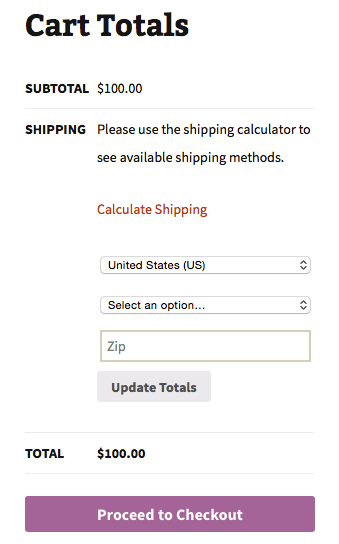 |
After the user provides the ship to information, the shopping cart will display the shipping rate estimates based on the settings entered in for the plugin.
| Appearance of shopping cart when viewed immediately after the ship to information is provided. Not all of the available service options are shown. | |
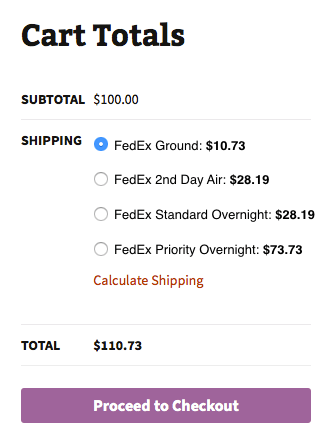 |
If the plugin is unable to display shipping rate estimates, the shopper will be directed to call in for a quote. Typical reasons why quotes may not be displayed include: 1) Insufficient data on the products in the shopping cart, such as weight or dimensions; 2) Invalid credentials due to a password change, an expired license, or a suspended account; 3) An invalid or incomplete ship to address was provided; or 4) The carrier’s web service is not operational.
| Appearance of shopping cart when the plugin is unable to display shipping rate estimates. | |
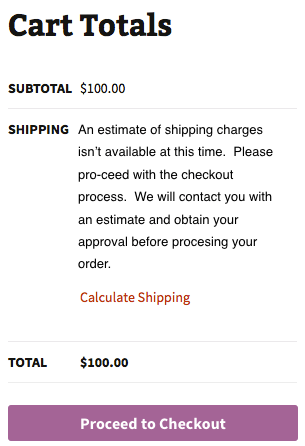 |
What you see. |
Return to top. |
The plugin populates shipping related information in the Additional Order Details widget on the Order Details page. The content of the widget falls into two categories: 1) Shipment Origin & Services; and 2) Shipment Content.
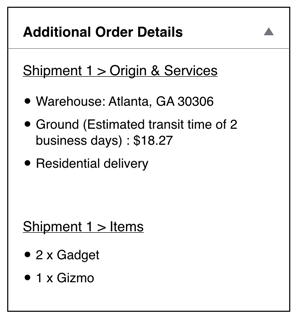
Shipment Origin & Services
This information block will identify the shipment origin, the selected carrier service and a list of any additional services (such as residential delivery) associated with the shipment. A separate Shipment Origin & Services information block will appear for each shipping location that will participate in fulfilling the order. This is particularly useful for stores with multiple warehouses and drop ship locations.
Shipment Content
A Shipment Content information block is presented beneath each Shipment Origin & Services information block. It identifies the products that were quoted as shipping from the location.
Managing Your Eniture API Key |
Return to top. |
You can manage your Eniture API Key by signing into eniture.com with the email address and password you entered when you registered for the plugin. After you sign in, My Account will be added to the navigation menu. Click on it to access the Dashboard for your account.

Use the links below to navigate to documents in the knowledge base related to common topics of interest.
Shipping with FreightDesk Online |
Return to top. |
- How capture the cost of shipping on orders placed online.
- How to ship the order, including how to create the shipping label (or Bill Of Lading in the case of LTL freight), schedule the carrier to pick up the shipment, and update the customer with the tracking number.
Quoting plugins, like this one, provide a solution for the first challenge. What are your options for the second challenge?
Option 1 – The carrier’s website: You can log into the carrier’s website and manually enter all of the relevant information. Carrier websites are free to use since the carrier makes money when you use them to deliver an order. However, if you have more than a handful of orders each day this approach is time consuming and ripe for data entry errors which can be costly to correct.
Option 2 – Use a plugin with “print-label” capabilities: It’s possible to find a plugin for certain shipping providers that will both generate quotes during the checkout process, and allow the merchant to print a shipping label. These plugins have very limited functionality and are usually an acceptable option only for merchants with very simple shipping needs and a low volume of shipments. They also require that the individuals responsible for preparing shipments have access to the ADMIN area of WooCommerce, which is not an acceptable arrangement to many merchants.
Option 3 – Cloud-based Shipping Platforms: The next step up in capability are cloud-based shipping systems that will connect to your online store and retrieve the details of your orders, thereby eliminating the need for much of the manual data entry. Many of these shipping systems have arrangements with postal and parcel carriers that can provide the merchant with significant discounts. Where these systems excel is in the efficiency of the fulfillment process. That translates in to a much higher volume of shipments per unit of time. These systems are relatively inexpensive and the reduction in the amount of labor and time it takes to ship your orders will pay dividends.
Option 4 – FreightDesk Online: FreightDesk Online (freightdesk.online) is also a cloud-based shipping system. It enjoys all of the benefits of other cloud-based offerings but expands the solution in two ways:
- It makes use of the detailed information collected by Eniture Technology’s quoting plugins (like this one) such as the packaging solution and the additional services included in the shipping option chosen when the order was placed.
- It provideds merchants access to more than two dozen LTL freight providers in addition to the typical postal and parcel integrations offered by other cloud-based solutions.
These expanded capabilities will deliver you closer to true “click-and-ship” shipping than any other alternative, whether you’re shipping with a postal carrier, a parcel carrier, or an LTL freight provider.
How to connect your WooCommerce store to FreightDesk Online |
Return to top. |
First, if you don’t already have one, register for a FreightDesk Online account (https://freightdesk.online/register). You can connect multiple online stores to FreightDesk Online, even if they use different e-commerce platforms, so you don’t have to create separate FreightDesk Online accounts for each one.
The pricing for FreightDesk Online is á la carte. You’ll be able to pick a separate plan for parcel (and postal) shipments, and for LTL freight shipments based on the anticipated volume for each type of shipping. Your monthly subscription rate will be comprised of these two selections. You can begin a 30-day trial of both types of shipping by selecting Trial in the corresponding dropdown fields on the registration form.
After you complete the registration process, log into FreightDesk Online. Click on your avatar located in the top right-hand corner of the browser window. Copy your FreightDesk Online ID which will be located below your company name.
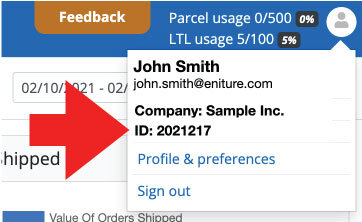
Return to the plugin settings and click on the FreightDesk Online tab. Enter your FreightDesk Online ID and click the Connect button.
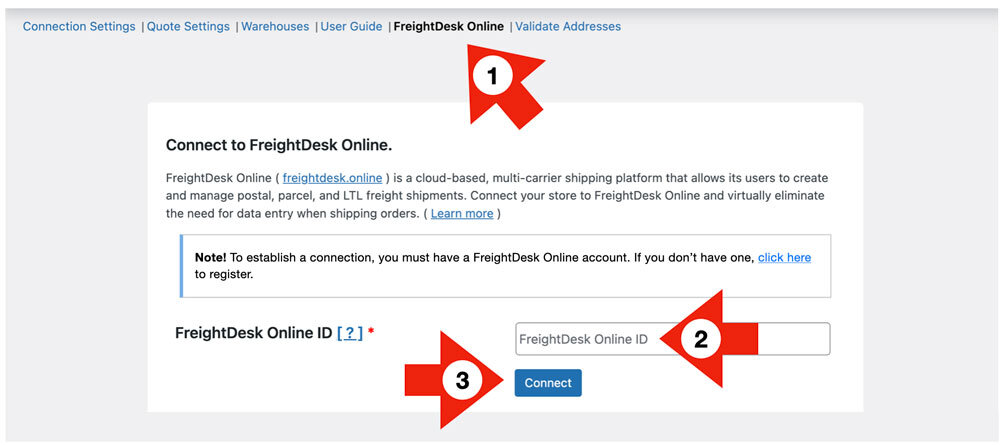
Complete the connection by granting any permissions that you’re prompted for.
Next, return to FreightDesk Online. Navagate to Settings > Connections. Locate the store in the list of Connected Marketplaces and click on its Show/Edit link. Update the marketplace’s connection settings using the instructions below.
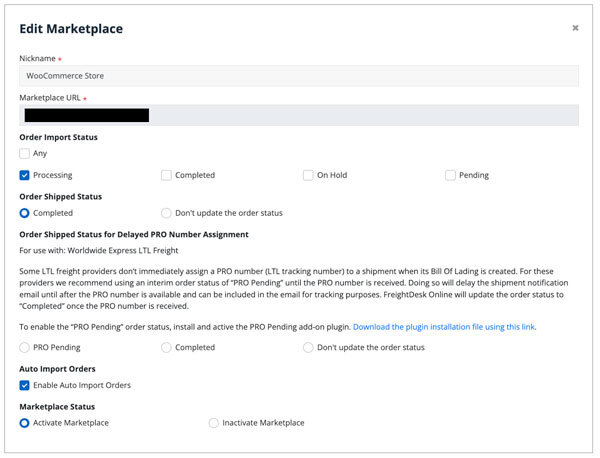
| Nickname | Enter a nickname you’d like to use to represent the connection to this store. Be aware that the nickname will be used to identify the store if you enable FreightDesk Online’s shipment tracking email notifications. It is used as the value for the “{Merchant}” mail-tag. |
| Marketplace URL | This field will be prefilled with the URL of the store that was connected to FreightDesk Online. You can not edit this field. To disable the connection, chose the Inactive Marketplace status option at the bottom of the page. |
| Order Import Status | This setting is used to filter which orders are imported into FreightDesk Online. Processing is typically the only order status enabled. |
| Order Shipped Status | Choose Completed if you want an order status seen in WooCommerce to be automatically updated to “Completed” when the shipping label or Bill Of Lading is printed. If you’d prefer to manually update the order status in WooCommerce, choose the option Don’t update the order status. |
| Order Shipped Status for Delayed PRO Number Assignment | You can ignore this setting if you won’t be connecting Worldwide Express to FreightDesk Online as an LTL freight provider. If you will be, then please read the information provided on-screen and install the add-on plugin. The add-on plugin will add “PRO Pending” as an additional order status in WooCommerce and will delay the order status from being updated to “Completed” until after a PRO number becomes available for the shipment. This is usually by 10:30 AM Eastern Time the next business day. |
| Auto Import Orders | Enable this setting if you’d like newly placed orders with the status(es) you identified in the Order Import Status setting to be automatically imported in to FreightDesk Online. The alternative is to initiate the import manually each time using the |
| Marketplace Status | Select Activate Marketplace to enable the store’s connection to FreightDesk Online. To disable it, choose Inactive Marketplace. |
When you’re done editing your marketplace settings, click the Test Connection button to verify the connection to the store, and then Update to save the settings and return to the Settings > Connections page.
Now that you’ve connected FreightDesk Online, unfulfilled orders can be imported in to FreightDesk Online for processing. To view them, log into FreightDesk Online and click on Orders in the navigation menu. If you have the Enable Auto Import Orders setting enabled, your orders will populate automatically. If not use the Import Orders button to manually initiate the process.
You’ll need to connect your shipping providers before you can start shipping your orders using FreightDesk Online. Connecting your shipping providers is also done on the Settings > Connections page. You can find a quick start guide in FreightDesk Online by navigating to Help > Getting Started. Short instructional videos are also sprinkled through FreightDesk Online. Click on the movie camera icon to view the video.


